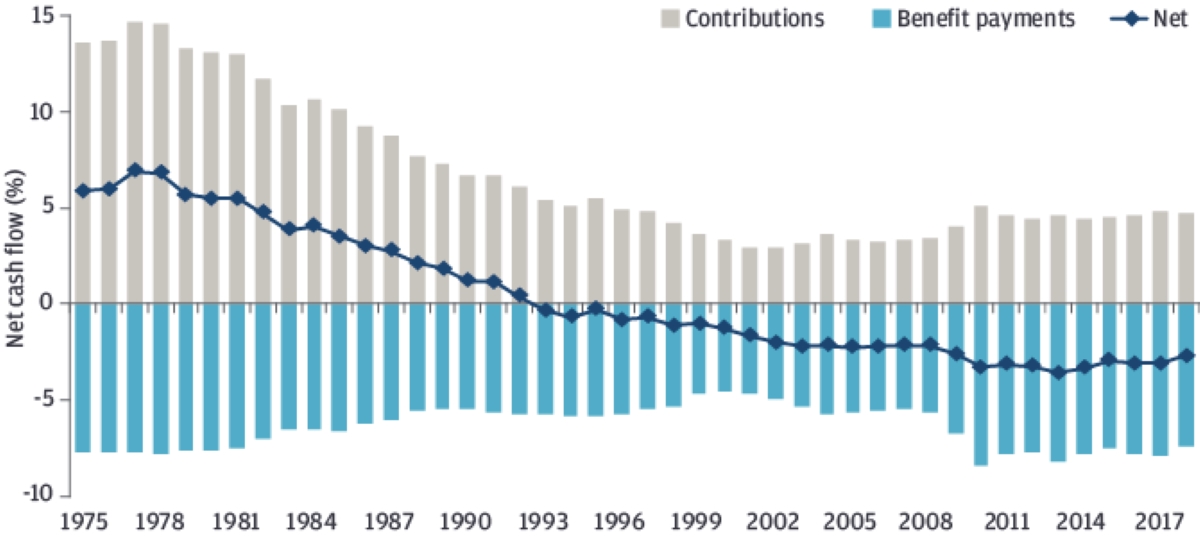

Finance
What Is Public Funding
Published: December 22, 2023
Discover the importance of public funding in the world of finance and learn how it can impact businesses and economic growth. Explore the various sources and benefits of public funding
(Many of the links in this article redirect to a specific reviewed product. Your purchase of these products through affiliate links helps to generate commission for LiveWell, at no extra cost. Learn more)
Table of Contents
- Introduction
- Definition of Public Funding
- Types of Public Funding
- Government Grants
- Tax Incentives
- Public-Private Partnerships
- Benefits of Public Funding
- Stimulating Economic Growth
- Promoting Social Welfare
- Supporting Innovation and Research
- Challenges of Public Funding
- Ensuring Accountability and Transparency
- Allocating Resources Fairly
- Conclusion
Introduction
Public funding plays a vital role in financing various initiatives and projects that contribute to the overall development and welfare of societies. It involves the allocation of resources from government entities to support a wide range of sectors, including education, healthcare, infrastructure, and research. This article aims to provide an overview of public funding, its definition, types, and the benefits it brings to communities.
Public funding is the financial support provided by governments at different levels, such as federal, state, or local, to fund programs and services that benefit the public. These funds may come from tax revenues, budget allocations, or special funds dedicated to particular sectors. Public funding serves as a mechanism to ensure the equitable distribution of resources and facilitate economic growth and social progress.
One of the primary purposes of public funding is to address societal needs and promote the well-being of citizens. By investing in areas such as education and healthcare, governments strive to build a stronger and more prosperous society. Additionally, public funding often plays a crucial role in stimulating innovation, fostering research and development, and supporting businesses in various sectors.
In the following sections, we will explore different types of public funding and delve into the benefits it brings to communities. We will also examine some of the challenges associated with public funding and the efforts required to ensure accountability and transparency in its utilization.
Definition of Public Funding
Public funding refers to the allocation of financial resources by government entities to support programs, services, and initiatives that are aimed at addressing societal needs and promoting the general welfare. It is a key mechanism through which governments invest in public goods, such as infrastructure development, education, healthcare, social services, and research.
At its core, public funding involves the utilization of taxpayer money to fund projects and activities that benefit the community as a whole. The funds can be derived from various sources, such as taxes, government revenues, grants, and donations. Governments have the responsibility to carefully manage and allocate these funds to maximize their impact and ensure equitable distribution.
Public funding plays a vital role in the functioning of government agencies and public institutions. It provides the necessary resources to deliver essential services, maintain public infrastructure, and promote economic growth. Moreover, public funding often serves as a catalyst for private investment, as it creates an enabling environment that attracts businesses and stimulates economic activity.
While public funding primarily involves the allocation of financial resources, it also encompasses non-monetary support through policies, regulations, and incentives. For example, governments may offer tax incentives or subsidies to encourage specific industries or activities that contribute to the public good.
Public funding is an essential tool for governments to address societal challenges and create a better quality of life for their citizens. It reflects a commitment to promoting social welfare, equitable access to resources, and sustainable development. Through smart and strategic allocation of resources, public funding can have a transformative impact on communities, improving education systems, healthcare services, infrastructure, and overall economic well-being.
Types of Public Funding
Public funding can take on various forms, each serving a specific purpose and catering to different sectors. Here are three common types of public funding:
- Government Grants: Government grants are financial awards provided by government entities to individuals, organizations, or businesses for specific projects or purposes. These grants are typically awarded through a competitive application process, and recipients are expected to use the funds for the intended purpose outlined in the grant agreement. Government grants can be instrumental in supporting research, social programs, arts and culture initiatives, and community development projects.
- Tax Incentives: Tax incentives are a form of public funding that involves providing tax breaks or reductions to individuals or businesses to encourage specific behaviors or investments. Governments may offer tax incentives to attract investments in certain sectors, stimulate economic growth in underdeveloped regions, or promote environmentally friendly practices. Common examples of tax incentives include tax credits for research and development activities, tax deductions for charitable donations, and tax exemptions for certain types of businesses.
- Public-Private Partnerships: Public-private partnerships (PPPs) are collaborative arrangements between government entities and private sector companies or organizations. In a PPP, both parties contribute resources, including financial investments, expertise, and infrastructure, to jointly undertake a project or provide a service. PPPs are often utilized to fund large-scale infrastructure projects, such as transportation systems, renewable energy facilities, and public utilities. By leveraging the strengths of the public and private sectors, PPPs can accelerate project implementation and improve service delivery.
These types of public funding mechanisms offer different approaches to address funding gaps and meet the diverse needs of communities. They not only provide financial support but also foster collaboration between government and non-government entities, promoting innovation and leveraging resources for greater impact.
Government Grants
Government grants are a significant component of public funding, providing financial support to individuals, organizations, and businesses in various sectors. These grants are typically awarded through a competitive application process and are intended to fund specific projects, research initiatives, social programs, or community development efforts.
Government grants serve as a vital source of funding for research and innovation in fields such as science, technology, healthcare, and social sciences. They enable researchers and scientists to explore new ideas, develop groundbreaking solutions, and drive advancements in knowledge and technology. By providing funding for research projects, government grants play a crucial role in promoting scientific discovery and fostering innovation.
Government grants are also instrumental in supporting social programs that aim to alleviate poverty, address community needs, and improve the well-being of vulnerable populations. Grants for social services, such as healthcare, education, and housing, help governments fulfill their commitment to providing essential services to citizens. Non-profit organizations and community groups often rely on government grants to implement programs and initiatives that enhance social welfare.
Moreover, government grants can play a vital role in fostering economic development and entrepreneurship. Small businesses and startups can benefit from grants designed to support entrepreneurship, innovation, and job creation. These grants provide financial assistance to entrepreneurs, enabling them to launch and grow their businesses, develop new products or services, and contribute to economic growth.
Government grants are subject to rigorous evaluation and accountability measures to ensure that funds are used for their intended purposes. Grant recipients are typically required to provide progress reports, financial statements, and evidence of project outcomes to demonstrate the effective use of the grant funds. This level of accountability helps to ensure transparency and promotes responsible allocation of public funds.
Overall, government grants form an integral part of public funding, enabling individuals, organizations, and businesses to pursue research, drive social change, foster economic development, and address pressing societal needs. They not only provide financial support but also play a pivotal role in advancing knowledge, promoting innovation, and improving the quality of life for individuals and communities.
Tax Incentives
Tax incentives are a powerful tool within public funding that governments use to encourage specific behaviors, investments, and activities. By providing financial benefits in the form of tax breaks or reductions, tax incentives aim to stimulate economic growth, promote certain industries or practices, and incentivize individuals and businesses to engage in desired behavior.
One common type of tax incentive is a tax credit, which directly reduces the amount of tax an individual or business owes. Tax credits can be targeted towards various areas, such as research and development, renewable energy investments, or hiring and training initiatives. These credits serve as a significant financial incentive for businesses to invest in innovation, sustainability, and workforce development.
Tax deductions are another form of tax incentive that allows individuals and businesses to subtract eligible expenses from their taxable income. This can include deductions for expenses related to education, healthcare, charitable donations, or business expenses. By lowering taxable income, tax deductions effectively decrease the overall tax liability, providing individuals and businesses with more disposable income or retained earnings.
Some governments may also implement tax exemptions, which allow certain entities or activities to be exempt from paying specific taxes altogether. For instance, governments may exempt charitable organizations from paying income tax or grant tax exemptions to encourage investments in economically disadvantaged areas.
Furthermore, tax incentives can be utilized to promote environmentally friendly practices and sustainability. Governments may offer tax credits or deductions to individuals or businesses that invest in renewable energy projects, purchase energy-efficient vehicles, or adopt eco-friendly practices. These incentives not only reduce the financial burden on those pursuing sustainable solutions but also contribute to environmental conservation and mitigating climate change.
It’s important to note that tax incentives are designed to achieve specific policy objectives and are subject to regulations and compliance requirements. Governments carefully evaluate the potential economic and societal impact of tax incentives to ensure their effectiveness and accountability.
Overall, tax incentives are a valuable tool within public funding that harnesses the power of the tax system to influence behavior and stimulate economic growth. By providing financial advantages to individuals and businesses, tax incentives spur investment, innovation, and sustainable practices, ultimately benefitting both the private sector and society as a whole.
Public-Private Partnerships
Public-Private Partnerships (PPPs) are collaborative arrangements between government entities and private sector companies or organizations. In a PPP, both parties join forces, pooling their resources and expertise, to jointly undertake a project or provide a service that benefits the public.
PPPs are commonly used to fund and manage large-scale infrastructure projects, such as transportation systems, power plants, water supply networks, and public buildings. By combining public sector oversight and private sector efficiency, PPPs aim to leverage the strengths of both sectors to accelerate project implementation, optimize resource allocation, and improve service delivery.
In a PPP, the government typically provides the necessary regulatory and legal framework, policy direction, and some level of financial support. The private sector, on the other hand, contributes capital investment, technical expertise, operational capabilities, and risk management skills. This collaboration allows the government to access private sector resources and innovation while sharing the risks and rewards of the project.
One of the significant advantages of PPPs is their ability to harness private sector efficiency and innovation to deliver public services. Private sector companies often bring specialized knowledge, advanced technology, and management expertise, which can result in cost savings, increased operational efficiency, and improved quality of services compared to traditional government-led initiatives.
PPPs can also provide additional funding sources that alleviate the burden on public budgets. Private sector partners may secure financing through loans, equity investments, or other financial arrangements, reducing the need for a fully government-funded project. This enables governments to embark on ambitious infrastructure projects that may have otherwise been financially unfeasible.
Furthermore, PPPs can foster innovation by encouraging experimentation and exploration of new approaches. The private sector’s profit motive and market-driven perspective often drive innovation, leading to the development of novel solutions and technologies within the public sector. This can result in improved service delivery, enhanced user experiences, and the adoption of more sustainable practices.
However, it is crucial to ensure that PPPs are structured in a way that safeguards public interests and maintains accountability. Transparency, clear contractual agreements, and robust monitoring mechanisms are necessary to ensure that projects are delivered on time, within budget, and in line with the public’s best interests.
In summary, public-private partnerships bring together the public and private sectors to leverage their respective strengths and resources, enabling governments to undertake ambitious projects, improve service delivery, and drive innovation. By combining public oversight with private sector efficiency, PPPs offer a collaborative approach to public funding that can address infrastructure needs and deliver value to the community.
Benefits of Public Funding
Public funding plays a crucial role in supporting societal development and addressing pressing needs within communities. Here are some key benefits of public funding:
- Stimulating Economic Growth: Public funding, such as government grants and tax incentives, can stimulate economic growth by providing financial support to businesses, entrepreneurs, and industries. It encourages innovation, research and development, and the creation of new products and services. Moreover, public funding for infrastructure projects creates jobs, attracts private investment, and enhances overall economic productivity.
- Promoting Social Welfare: Public funding ensures that essential services, such as education, healthcare, and social services, are accessible to all members of society. By investing in these areas, governments can improve the quality of life, reduce inequalities, and enhance social equity. Public funding for social welfare programs also supports vulnerable populations, promotes inclusion, and contributes to a stronger and more cohesive society.
- Supporting Innovation and Research: Public funding for research and innovation drives advancement in various fields, including science, technology, medicine, and social sciences. It allows researchers and scientists to pursue cutting-edge projects, discover new knowledge, and develop solutions to complex challenges. Public funding for research also positions countries at the forefront of innovation, attracting talent, fostering collaboration, and spurring economic growth.
- Encouraging Entrepreneurship: Public funding initiatives, such as grants and tax incentives for startups and small businesses, provide support for entrepreneurs to launch new ventures, create jobs, and drive economic development. By reducing financial barriers, public funding encourages entrepreneurial activity, fosters innovation, and stimulates the growth of new industries.
- Promoting Sustainable Development: Public funding can be directed towards promoting sustainability and mitigating climate change. Investments in renewable energy, eco-friendly practices, and environmentally sustainable infrastructure contribute to a greener future. By incentivizing sustainable practices through tax incentives and grants, public funding helps drive the transition to a more sustainable and resilient society.
- Enhancing Public Services: Public funding is vital for the delivery and improvement of public services, including transportation, utilities, public safety, and cultural and recreational facilities. Adequate funding ensures the maintenance and expansion of critical infrastructure and essential services that enhance the well-being and quality of life for communities.
These benefits highlight the far-reaching impact of public funding on various aspects of society, from economic growth to social welfare and environmental sustainability. By strategically allocating resources and investing in key areas, governments can drive progress, create opportunities, and build prosperous and inclusive communities.
Stimulating Economic Growth
One of the significant benefits of public funding is its ability to stimulate economic growth. Through various funding mechanisms, governments can provide critical support to businesses, entrepreneurs, and industries, creating an environment conducive to economic development. Here are some key ways in which public funding stimulates economic growth:
1. Financing Infrastructure: Public funding plays a critical role in financing infrastructure projects, such as transportation systems, power plants, and communication networks. These infrastructure investments not only create jobs during the construction phase but also provide the necessary foundation for economic activities. Improved transportation systems, for example, enhance connectivity and facilitate the movement of goods and services, boosting trade and economic growth.
2. Supporting Small Businesses and Startups: Public funding initiatives, such as grants and loans, are often targeted towards small businesses and startups. These financial resources provide essential support for entrepreneurs to launch and grow their ventures, create jobs, and drive local economies. Public funding can also offer mentorship programs, business incubators, and resources for capacity-building, further strengthening the ecosystem for small business development.
3. Encouraging Research and Development: Public funding for research and development enables scientists, researchers, and inventors to pursue innovative projects without the financial constraints often associated with such endeavors. By investing in cutting-edge research, governments fuel advancements in technology, healthcare, and other sectors. Research and development activities lead to the development of new products, processes, and services, driving economic growth and enhancing competitiveness.
4. Attracting Foreign Investment: Public funding initiatives can attract foreign investment by providing incentives such as tax breaks, grants, or subsidies. These incentives encourage foreign companies to invest in local markets, bringing in new capital, expertise, and job opportunities. Foreign direct investment boosts domestic industries, stimulates economic activity, and contributes to long-term sustainable growth.
5. Fostering Innovation: Public funding creates an environment that encourages and supports innovation. By providing financial resources for research and innovation programs, governments nurture a culture of creativity and problem-solving. This leads to the development of new technologies, products, and services that drive economic growth and improve productivity across sectors.
6. Developing Human Capital: Public funding for education and workforce development initiatives equips individuals with the skills and knowledge required to participate in the labor market. A well-educated workforce contributes to higher productivity, innovation, and overall economic growth. Public funding also supports initiatives aimed at upskilling and reskilling workers, ensuring that they can adapt to changing economic demands and remain competitive.
These various ways in which public funding stimulates economic growth highlight its vital role in creating a conducive environment for businesses, innovation, and infrastructure development. By strategically allocating resources, governments can drive economic activity, job creation, and overall prosperity within their respective economies.
Promoting Social Welfare
One of the primary objectives of public funding is to promote social welfare and ensure the well-being of individuals and communities. Through targeted investments and support in key areas, governments can address inequalities, enhance access to essential services, and create a more equitable society. Here are some ways in which public funding promotes social welfare:
1. Access to Education: Public funding plays a crucial role in ensuring that education is accessible to all individuals, regardless of their background or financial means. Investments in education support the development of quality schools, scholarships, and educational grants, making education more affordable and enabling individuals to acquire the knowledge and skills needed to succeed in their personal and professional lives. By promoting access to education, public funding helps reduce socio-economic disparities and empowers individuals to improve their circumstances.
2. Healthcare Services: Public funding is vital in supporting healthcare systems and ensuring that quality healthcare is accessible to all members of society. Investments in public hospitals, clinics, and medical programs provide essential services to individuals who may not have the resources to afford private healthcare. Public funding also contributes to research and development in medicine, enabling the discovery of new treatments, advancing medical technology, and improving overall healthcare outcomes.
3. Social Safety Nets: Public funding directs resources toward creating and maintaining social safety nets to support vulnerable populations. Programs such as social assistance, unemployment benefits, and disability support offer a safety net for those facing financial hardships. By providing a basic level of income and support, these initiatives prevent individuals and families from falling into poverty and help promote social stability.
4. Affordable Housing: Public funding can be directed towards affordable housing initiatives, ensuring that individuals and families can access safe and affordable housing. By subsidizing housing projects, providing rental assistance, or offering low-interest loans, governments can address the issue of housing affordability, reduce homelessness, and contribute to stable and thriving communities.
5. Community Development Programs: Public funding supports community development programs that aim to improve the quality of life in specific regions or neighborhoods. These programs may include the revitalization of infrastructure, the development of community centers and public spaces, and initiatives that foster social cohesion and civic engagement. By investing in community development, public funding helps create vibrant, inclusive, and sustainable communities.
6. Support for Non-Profit Organizations: Public funding often provides financial support to non-profit organizations that work towards advancing social causes and addressing societal challenges. Grants and funding opportunities enable these organizations to deliver critical services, promote community engagement, and advocate for social change. Public funding ensures that non-profit organizations can continue their vital work and make a positive impact on society.
Through these various avenues, public funding plays a vital role in promoting social welfare, reducing inequalities, and creating a more inclusive society. By providing the necessary resources and support, governments can enhance the well-being of individuals, strengthen communities, and foster a more equitable and compassionate society.
Supporting Innovation and Research
Public funding plays a crucial role in supporting innovation and research, driving advancements in various fields and fostering economic growth. By providing financial resources and a supportive environment, governments can encourage scientists, researchers, and inventors to explore new ideas, make discoveries, and develop groundbreaking solutions. Here are some key ways in which public funding supports innovation and research:
1. Funding Research Projects: Public funding provides the necessary financial support for researchers to undertake exploratory and applied research projects. These funds enable scientists and researchers to conduct studies, gather data, perform experiments, and develop new theories and methodologies. By supporting research projects, public funding contributes to the expansion of knowledge across various disciplines, including science, technology, medicine, social sciences, and humanities.
2. Encouraging Collaboration: Public funding initiatives often promote collaboration among researchers, institutions, and industry partners. By fostering collaboration, governments facilitate the sharing of knowledge, expertise, and resources, leading to cross-disciplinary innovation and breakthroughs. Collaborative research projects supported by public funding enhance the quality and impact of research outcomes and stimulate further innovation.
3. Promoting Technology Transfer: Public funding facilitates the commercialization of research findings and supports the transfer of technology from academic institutions to the private sector. Through technology transfer programs and funding initiatives, governments encourage researchers to develop practical applications for their discoveries, leading to the creation of new products, processes, and industries. Public funding helps bridge the gap between research and market implementation, supporting technological innovation and economic growth.
4. Providing Access to Research Facilities: Public funding helps establish and maintain research facilities and infrastructure. Access to state-of-the-art laboratories, scientific equipment, and specialized research facilities enables scientists and researchers to conduct high-quality research that would not be possible without adequate resources. Publicly funded research facilities serve as hubs for collaboration, innovation, and knowledge exchange.
5. Supporting Startups and Entrepreneurship: Public funding initiatives often provide support for startups and entrepreneurs to establish and grow their businesses. Grants, loans, and incubation programs enable entrepreneurs to access capital, mentorship, and resources to bring innovative ideas to market. Public funding for startups and entrepreneurship fosters a culture of innovation and business growth, driving economic development and job creation.
6. Addressing Societal Challenges: Public funding focuses on research that addresses pressing societal challenges, such as healthcare, climate change, poverty, and sustainability. By directing resources towards these areas, governments encourage researchers to find innovative solutions to these complex problems. Publicly funded research plays a vital role in driving social progress, creating sustainable solutions, and improving the well-being of communities.
Public funding for innovation and research provides the necessary support and resources for scientists, researchers, and entrepreneurs to pursue groundbreaking ideas, drive technological advancements, and stimulate economic growth. By investing in innovation and research, governments play a critical role in shaping the future, fostering economic prosperity, and addressing societal challenges.
Challenges of Public Funding
While public funding plays a crucial role in supporting societal development and addressing community needs, there are several challenges that governments must navigate to ensure effective and efficient allocation of resources. Here are some key challenges associated with public funding:
1. Ensuring Accountability and Transparency: One of the primary challenges of public funding is ensuring accountability and transparency in the allocation and utilization of funds. Governments must establish robust financial tracking systems and implement effective monitoring mechanisms to ensure that public funds are used for their intended purposes. Additionally, transparency in decision-making processes and reporting mechanisms is essential to maintain public trust and confidence in the use of public funds.
2. Allocating Resources Fairly: Public funding often involves making difficult decisions regarding resource allocation. Limited resources may lead to competition among sectors and programs, making it challenging to allocate funds in a fair and equitable manner. Governments must navigate these competing demands and prioritize needs based on societal impact, sustainability, and long-term goals.
3. Adapting to Changing Priorities: Public funding needs to be flexible and responsive to changing societal priorities and emerging challenges. Governments must continuously assess and reallocate resources to address new issues and evolve with changing circumstances. This requires effective planning, governance, and the ability to adjust funding strategies to align with evolving needs.
4. Managing Political Pressures: Public funding decisions can be subject to political pressures and influence. Political considerations, such as electoral cycles and pressure from interest groups, may impact resource allocation and funding decisions. Governments must strive to maintain independence and integrity in the decision-making process to ensure that public funds are allocated based on evidence, societal need, and long-term benefits.
5. Fostering Innovation and Risk-taking: Public funding can sometimes be risk-averse, favoring safe and proven initiatives over more innovative and potentially transformative projects. Promoting innovation requires governments to be open to supporting high-risk, high-reward endeavors and providing resources for experimentation and exploration of new ideas. Balancing risk management with the need for innovation is a constant challenge in public funding.
6. Sustainable Funding Sources: Securing sustainable funding sources for public initiatives can be challenging. Economic fluctuations, changes in government priorities, and budget constraints may impact the availability of funding. Governments need to develop long-term funding strategies, explore alternative sources of revenue, and ensure financial stability to sustain public funding initiatives.
Addressing these challenges requires sound governance, effective financial management, and a commitment to transparency and accountability. Governments must continuously assess and adapt their funding strategies to meet the evolving needs of communities and overcome the challenges associated with public funding.
Ensuring Accountability and Transparency
One of the critical challenges of public funding is ensuring accountability and transparency in the allocation and utilization of funds. Accountability refers to the responsibility of governments to manage public funds efficiently, while transparency refers to the open and accessible reporting of financial information and decision-making processes. Ensuring accountability and transparency in public funding is essential to maintain public trust, prevent misuse of resources, and foster effective governance. Here are some key aspects of ensuring accountability and transparency:
1. Robust Financial Management Systems: Governments need to establish and maintain robust financial management systems that enable accurate and transparent tracking of public funds. This includes effective budgeting, accounting, and auditing processes to ensure that funds are allocated and used in accordance with specific guidelines and regulations.
2. Independent Auditing and Oversight: Independent audit agencies play a crucial role in holding governments accountable for the use of public funds. Governments should ensure the independence and integrity of audit agencies to conduct unbiased and thorough examinations of financial records and practices. These audits help identify any discrepancies or potential mismanagement, promoting transparency and accountability in the public funding process.
3. Transparent Reporting and Disclosures: Governments should provide accessible and comprehensive financial reports and disclosures that outline the allocation and utilization of public funds. Transparent reporting enables stakeholders, including the public, to understand how funds are being spent and whether they align with the intended purposes. Regular and timely reporting enhances transparency and offers an opportunity for public scrutiny and accountability.
4. Public Participation and Engagement: Governments should promote public participation and engagement in the decision-making processes related to public funding. This can involve soliciting public input, conducting public consultations, and encouraging feedback from citizens. Involving the public in decision-making fosters transparency, increases public awareness, and promotes a sense of ownership over public funds.
5. Whistleblower Protection: Whistleblower protection mechanisms are crucial to encourage individuals to report any suspected fraud, corruption, or mismanagement of public funds. Governments should establish mechanisms to protect whistleblowers from retaliation and ensure confidential reporting channels. Whistleblower protection helps uncover any misuse of funds and supports transparency and accountability.
6. Integrity and Ethics: Governments should prioritize integrity and ethical conduct in all aspects of public funding. This includes clear codes of conduct, conflict of interest regulations, and the prevention of bribery and corruption. Upholding high ethical standards ensures that public funds are used for their intended purposes and promotes public confidence in the integrity of the funding process.
Ensuring accountability and transparency in public funding requires a commitment to good governance, effective oversight mechanisms, and a culture of transparency and integrity. By implementing these measures, governments can build public trust, effectively manage public resources, and ensure that public funding initiatives have a positive impact on society.
Allocating Resources Fairly
One of the significant challenges in public funding is allocating resources fairly and equitably. With limited resources available, governments must make difficult decisions to distribute funds across different sectors, programs, and regions. Allocating resources fairly involves ensuring that funding decisions are based on objective criteria and prioritize societal needs. Here are some key considerations for allocating resources fairly:
1. Needs-Based Allocation: Governments should prioritize resource allocation based on the identified needs of communities and sectors. Conducting comprehensive needs assessments can help determine areas where resources are most required, ensuring that funding reaches those who need it the most. By focusing on areas of greatest need, governments can address disparities and ensure a more equitable distribution of resources.
2. Evidence-Based Decision Making: Allocating resources fairly requires a data-driven approach that relies on evidence rather than subjective factors. Governments should base funding decisions on solid evidence, research, and analysis. This helps ensure that resources are directed to programs and initiatives that have proven effectiveness and maximize societal impact.
3. Transparent Criteria and Processes: Governments should establish clear and transparent criteria and processes for resource allocation. This includes outlining the factors and considerations that influence funding decisions and ensuring that these criteria are communicated openly to stakeholders. Transparency in the allocation process helps build trust and enables stakeholders to understand how decisions are made.
4. Equitable Regional Distribution: Governments must allocate resources equitably across different regions to avoid geographical disparities. This means considering the unique needs, challenges, and opportunities of each region and ensuring that funding is distributed proportionately. Equitable regional distribution helps reduce regional inequalities and promotes balanced development.
5. Avoiding Political Bias: Resource allocation should be free from political bias or favoritism. Governments must strive to make funding decisions based on objective criteria and avoid diverting resources for political gain. This requires strong governance frameworks and mechanisms to ensure the integrity and impartiality of the allocation process.
6. Review and Evaluation: Governments should regularly review and evaluate the impact and effectiveness of resource allocation. This enables policymakers to assess the outcomes of funding decisions, identify any potential biases or shortcomings, and adjust allocation strategies accordingly. Ongoing evaluation promotes continuous improvement, ensuring that resources are allocated in a fair and efficient manner.
Allocating resources fairly in public funding requires a commitment to equitable distribution, evidence-based decision making, and transparency. By prioritizing needs, establishing clear criteria, and avoiding biases, governments can ensure that resources reach those who need them the most, address disparities, and contribute to a more just and equitable society.
Conclusion
Public funding plays a vital role in promoting economic development, social welfare, innovation, and research. Through various funding mechanisms such as government grants, tax incentives, and public-private partnerships, governments allocate resources to address societal needs and support initiatives that benefit the public.
Public funding stimulates economic growth by financing infrastructure, supporting small businesses and startups, and fostering innovation and research. It promotes social welfare by ensuring access to education, healthcare, affordable housing, and social services. Additionally, public funding drives innovation and research by funding projects, encouraging collaboration, and supporting technology transfer.
However, public funding is not without its challenges. Ensuring accountability and transparency in the allocation and utilization of funds is crucial, as is the equitable allocation of resources and the ability to adapt to changing priorities. Overcoming these challenges requires robust financial management systems, independent oversight, transparent reporting, and public participation in decision-making.
In conclusion, public funding is a powerful tool for governments to invest in the development and well-being of societies. By allocating resources strategically, promoting transparency and accountability, and addressing societal needs, public funding can drive economic growth, promote social welfare, support innovation, and contribute to a more equitable and prosperous future for all.














